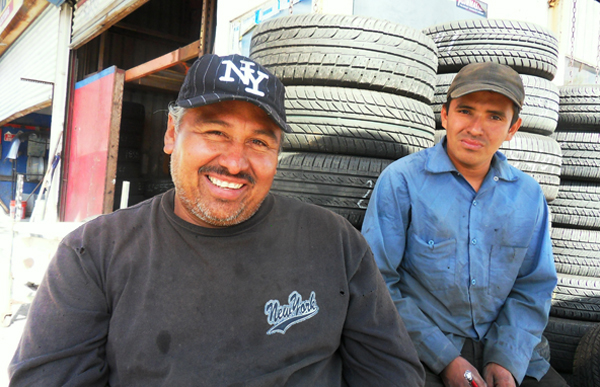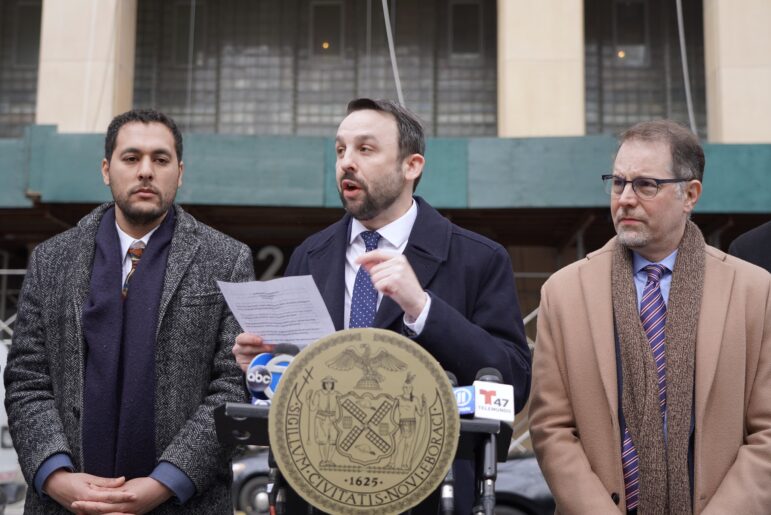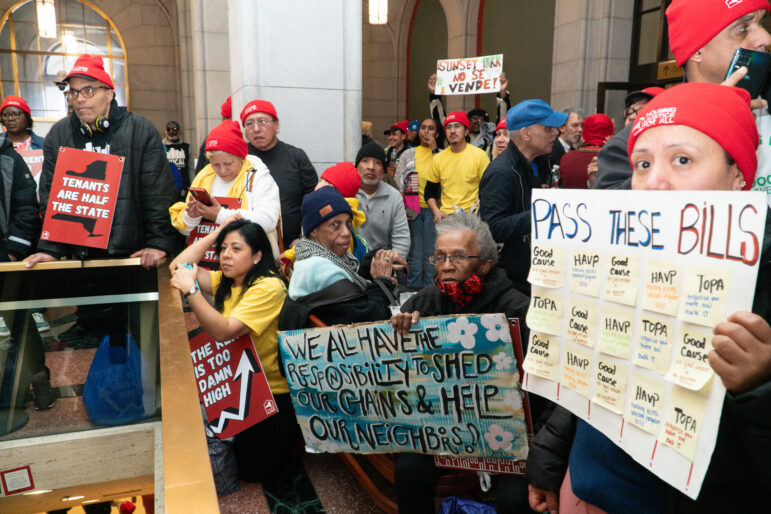
Photo by: Joey Arden
Marlon Ramirez, left, and a colleague. They’re among the 1,700 workers whose employers will have to relocate as the city’s Willets Point redevelopment plan rolls ahead.
Willets Point was still doing brisk business in the middle of October, a week after the City Council had approved its demise, making way for a planned, decades-long redevelopment anchored by a large shopping mall on the park across the street. Outside of a Quonset garage on a corner of 126th Street, Marlon Ramirez took his lunch break next to a stack of tires under the shade of a beach umbrella.
He had first come to Willets Point in the 1980s, an immigrant from Honduras, unskilled and in need of a job. He trained as a car mechanic, and over the next three decades the job supported Ramirez, his two children and his mother in Jamaica, Queens, as well as a disabled brother back in Tegucigalpa. Now he wondered about the future.
For years, the city has been buying up parcels along this stretch of auto-repair shops, with some owners selling amid the active threat of eminent domain. It now owns most (but not all) of the redevelopment site, and it’s offered to help relocate businesses.
The city has already tapped two developers to take over the site: The Related Companies, a key player in other development plans by the Bloomberg administration, and Sterling Equities, the real estate firm of Mets owners Fred Wilpon and Saul Katz.
But Ramirez’s employer has yet to find new space, and will have to clear out by the end of November in order to get the relocation money promised from the city. No compensation has been offered to Ramirez if he loses his job. He’s one of 1,700 workers employed by the 260 shops on Willets Point. Wiping his weathered fingers on a grimy T-shirt, he noted the new mall would have jobs, but those jobs were not for him.
“Maybe I’ll go to Brooklyn,” he said in halting English. “The mall won’t pay me what I make here. But this will all be a parking lot.”
A panic on Willets Point
In August the city’s Economic Development Corporation (EDC) sent a letter to 90 Willets Point businesses occupying land now owned by the city in the footprint of the redevelopment’s first phase. The letter offered the businesses payments equal to 12 months of their current rents if they relocated by the end of November. If they wait until the end of January, the payments would be equal to six months, as long as there’s still money left in the kitty. The payments would come out of a $3.5 million “supplemental” fund and be doled out on a “first-come, first-serve basis.”
Muffler shop owner Jamie Sabeti said his rent on an unheated three-bay garage was $2,500 a month, putting his potential payout from the city at just $30,000. “That’s not enough,” he said, waving a real-estate listing supplied by the city’s relocation firm. The ad asked double his current rent for a garage in Staten Island. Sabeti employs six people who would likely lose their jobs in such a move—if he can move. “It took me five years to build up enough customers here,” he said. “I’ve been in business for 15 years, and I’m going to have to shut down and start over again. What am I going to do in Staten Island? Some shops around here pay just $700 a month [in rent], so the city wants to give them six times $700? That’s not right. The city is giving hundreds of millions to these developers, plus it’s giving them all the land for a buck, and they want us to just disappear.”
Read the rest of this series:
Part 1:
Will a New Mayor Do Development Differently?
Part 2:
Trading Parkland for Developer’s Donation
The Willets Point shops will only get a piece of that “supplemental” and group-relocation money if they can find space and move by the end of November. That looks like a tough task. One of the cooperative’s leaders told City Limits that he and other shop owners were being shown properties by the city’s relocation firm, the Cornerstone Group, but no deals had been reached yet. Cornerstone had already collected $369,955 on a $645,000 contract to relocate businesses, but at a September City Council hearing, sparsely attended by Council members, the city revealed that just 10 of the 90 affected businesses had been moved so far. The businesses owners complained they received little more than real estate ads for impractical and expensive locations. But by the time they made this case at the hearing, only one Councilman heard their testimony.
A familiar ring
While Cornerstone did not return calls for this story, the predicament of the Willets Point shop owners sounded awfully familiar to Stanley Mayer, who led the fight to keep 23 merchants together after the city had tapped the Related Companies to build another city-subsidized shopping mall on the site of the old Bronx Terminal Market eight years ago. A dozen former market merchants tracked down for this story all said they ultimately had no help in locating their new places. The other half could not be found; the surviving merchants said these shops were forced out of business, including one of the largest, Cuba Tropical, a 28-year-old produce firm with nearly 60 employees that moved to New Jersey before shutting down.
“We tried to sue Related, but they were too big for us,” recalls Kwabena Adjei, manager of Gold Coast Trading, an African food wholesaler now in Melrose. Though Gold Coast has since opened a second outpost in Brooklyn, Adjei says it had to struggle to regain its footing. “Everybody wanted to stay together as a market, but we all had to find our own spaces. It was difficult at first.” Gold Coast was forced to take a bigger space that needed extensive renovation. “It’s been more than six years now, and this is the first I’m hearing that we were supposed to get help from the city.”
Mayer’s father and uncle had started the food wholesaler Siegmund Strauss at the Bronx Terminal Market in 1967. Now Mayer regards his battle to keep the merchants together as a quixotic quest to stop a steamroller. “When it was over, it was over,” he says. After the City Council voted to approve the new mall in 2006, a philosophical Mayer stood outside on the City Hall steps and pointed up at the building’s clock tower. “You ever hear, ‘You can’t fight City Hall?’ ” he asked. “They were talking about this place.”
Mayer remembers Cornerstone owner Gary Curry had shown him and others possible new locations. “He gave us a tour of the Bronx, and showed us lots of spaces, but nothing really worked well for anybody,” Mayer says. “As a matter of fact, I was just renegotiating my lease with our landlord, and I did another tour of the Bronx and saw some of the same properties I saw six years ago were still available.”
Mayer finally found his own space—just across 149th Street—where he remains to this day. Others were not so lucky. “Most of the businesses have now closed,” Mayer says. “The small guys went down first, but then the largest of us closed, too.” He empathizes with the Willets Point shops trying to stay together as a market. “We were right—there was a synergy among us. That’s a market, and if they’re saying the same thing, they’re right. We did well with each other, but then we were scattered to the four winds.”
For providing relocation services to the Bronx Terminal Market merchants in 2005 and 2006, Cornerstone was paid $149,350 from EDC.
Echoes from the Bronx
With every city-subsidized development, Mayor Michael Bloomberg makes sure to mention the number of jobs that will be created. Unfortunately, these numbers are often subject to change.
For Related’s $500 million mall at the old Bronx Terminal Market, for example, Bloomberg said 5,000 jobs would be realized. His “Five Borough Economic Opportunity Plan,” however, put the number of construction and permanent jobs at 4,500, 2,100 of them permanent. But by the time that deal got sealed, the projected number of permanent jobs had been lowered to 1,766. Currently the one-million-square-foot shopping mall supplies just 479 full-time jobs and 934 part-time positions..
The Bloomberg administration claimed the old Bronx Terminal Market employed “approximately” 300 full-time workers at two-dozen businesses, but Susan Fainstein, a professor of urban planning at Harvard’s Kennedy School of Government, put the number of market jobs at 750, with many of the positions unionized, unlike the mall. Stanley Mayer used to take pride in introducing a longtime cashier who had sent her daughter to medical school. “How can you raise a family selling pants at the Gap?” he asked. Before the mall took over the market, Mayer employed 50 workers. Now he’s down to 20.
“I just don’t see how this is such a great deal for the city. It may be better than what they had, but the malls, with the same stores, are putting all the little people out of business. Go anywhere, on any interstate, and you see the same types of places, the Home Depots, Target, it’s all the same. New York seems to be the last bastion of the little shops, the little restaurants, the little grocery stores, but that’s changing too.”
Willets Point braces
The threat to small businesses was one of the major objections the Queens Civic Congress had to the Willets Point plan. “There is no need for this mall,” says Richard Hellenbrecht, president of the umbrella organization of 106 civic and community groups. “There are already several malls in the area, some of which are struggling.” The Shops at Atlas Park, for example, was recently bought at a foreclosure auction.
The city says the proposed Citi Field mall and related redevelopment on Willets Point will create 7,100 permanent jobs and 12,000 construction jobs. But it’s hard to get a handle on these numbers given the 15-year period before the first housing is offered. In Related and Sterling’s original proposal to put a casino in the park, an even larger shopping mall would have provided just 972 jobs, meaning the current plan’s mall will provide substantially more jobs even though it’s smaller. It’s also not clear whether all the new jobs will pay the $10 living wage mandated by the City Council. In 2008, the New York City Central Labor Council had exacted a promise that jobs would pay $10 an hour with health insurance, or $11.50 without, but that guarantee was later dropped from the project. The higher of those wages would bring in just $23,920 a year.
While the city says 260 shops on Willets Point employ more than 1,700 workers, it has not looked at the wages and quality of these jobs. A survey by the Urban Justice Center found half of the Willets Point workers earn under $26,000 a year, but about 38 percent make between $26,000 and $35,000 a year, and 12 percent make between $35,000 and $60,000. The national average wage of an auto service worker in 2010 was $35,790. The U.S. Bureau of Labor Statistics says future prospects are good for that skill set.
A parade of protesters marched down 126th Street in the July heat to demand more affordable housing in the Willets Point redevelopment. Sabeti stood in front of his muffler shop and worried about the future. “They want housing, but where will we go?” he asked. “We don’t know what we’re going to do—we have nowhere to go.”
This article was reported in partnership with The Investigative Fund at The Nation Institute with support from the Puffin Foundation.








